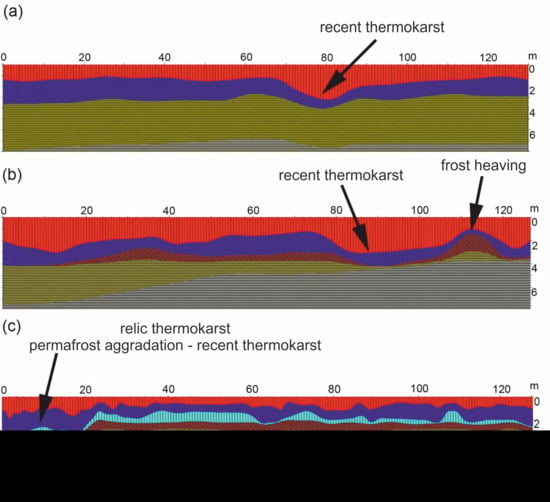Hazards of Activation of Cryogenic Processes in the Arctic Community: A Geopenetrating Radar Study in Lorino, Chukotka, Russia
Abstract
1. Introduction
- To collect the available geological data from point sources (boreholes and exposure);
- To track the interfaces of a thawed layer and permafrost layers having contrasting electrophysical properties using GPR;
- To reconstruct recent geological processes, including hazardous thermokarst, thermal erosion, and frost heaving.
2. Materials and Methods
2.1. Study Site
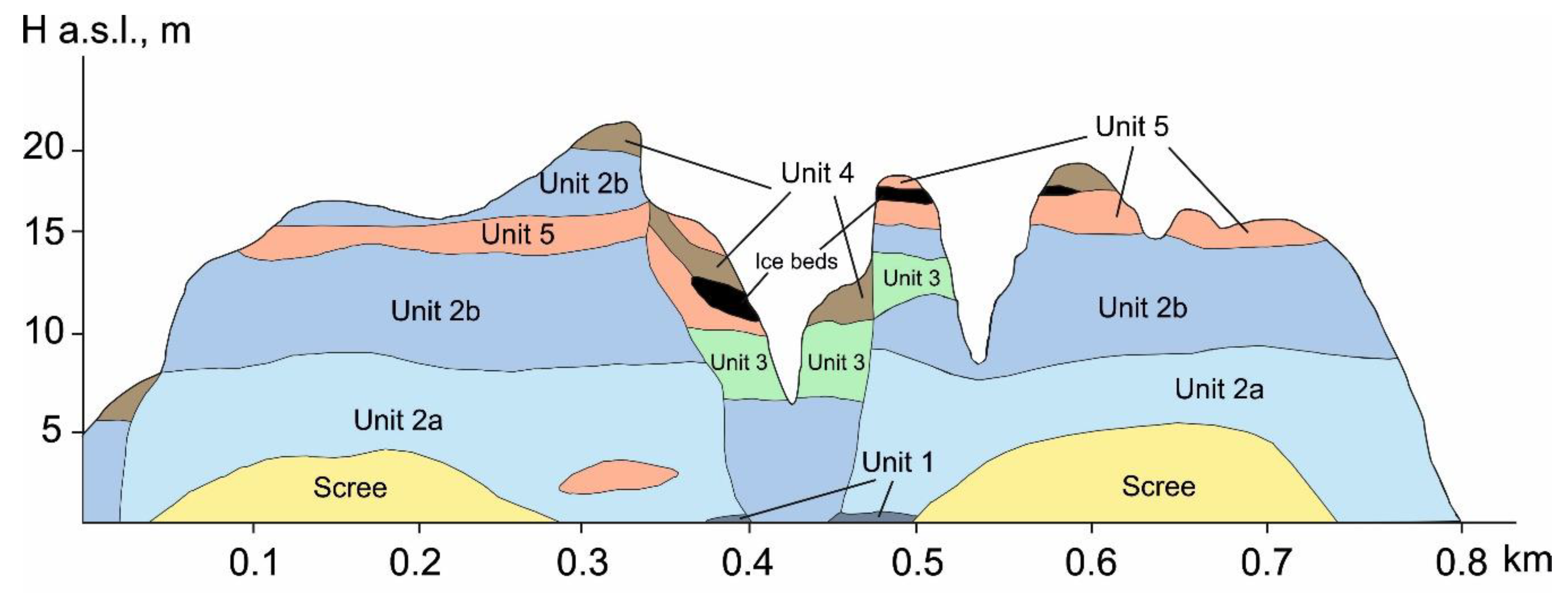
2.2. Methods and Instruments
2.2.1. Reconnaissance Survey
2.2.2. Etalon Geological and Geophysical Sections
2.2.3. Collection and Processing of Geo-Penetrating Radar (GPR) Transects
2.2.4. Spatial Modeling Based on the Grid of Transects
3. Results and Discussion
3.1. Etalons
- A—thawed layer (0.6–1.8 m thick), comprising of soil or ground filling, and representing the active layer at the time of study;
- B—ice-rich permafrost (total moisture content up to 35 wt%) with up to 1.4 m thick lenses of ice along the bottom (0.1–2.5 m), frozen ice-rich ground filling, and the transient layer, which were hard to recognize;
- C—cryotic sandy layer (total moisture content as low as 1 wt%, Unit 2b) (1–3 m), with blurred bottom;
- D—frozen loams and sandy loams (Unit 5).
- A—Layer A (1.0–1.2 m thick);
- B—Layer B (1.0–2.5 m);
- E—massive ice of various origins (up to 1.5 m);
- F—organic-rich frozen silts (0.5–1.3 m) with moisture content up to 65–70 wt% (Unit 4);
- D—Layer D, which included both the sandy loams and fine sands disclosed by the borehole at 8 m, but not recognized in the radargram.
3.2. GPR Performance in Built-Up Areas of the Permafrost Zone
- ε = 4–8 for the active layer;
- ε = 6–9 for ice-rich fine sediments;
- ε = 3.5–4.5 for massive ice beds;
- ε = 20–40 for buried peat and organic-rich soils;
- ε = 12–16 for frozen loams.
3.3. Permafrost Structure: Reconstruction and Predicting of Cryogenic Processes
4. Conclusions
Author Contributions
Funding
Acknowledgments
Conflicts of Interest
References
- Grebenets, V.I.; Streletskiy, D.; Shiklomanov, N. Geotechnical safety issues in the cities of Polar regions. Geogr. Environ. Sustain. 2012, 5, 104–119. [Google Scholar] [CrossRef]
- Humlum, O.; Instanes, A.; Sollid, J.L. Permafrost in Svalbard: A review of research history, climatic background and engineering challenges. Pol. Res. 2003, 22, 191–215. [Google Scholar] [CrossRef]
- Cheng, G. A roadbed cooling approach for the construction of Qinghai–Tibet Railway. Cold Reg. Sci. Technol. 2005, 42, 169–176. [Google Scholar] [CrossRef]
- Instanes, A.; Anisimov, O.; Brigham, L.; Goering, D.; Khrustalev, L.N.; Ladanyi, B.; Larsen, J.O. Infrastructure: Buildings, support systems, and industrial facilities. In Arctic Climate Impact Assessment; Cambridge University Press: New York, NY, USA, 2005; pp. 907–944. [Google Scholar]
- Ford, J.D.; Bell, T.; St-Hilaire-Gravel, D. Vulnerability of Community Infrastructure to Climate Change in Nunavut: A Case Study from Arctic Bay. In Community Adaptation and Vulnerability in Arctic Regions; Springer Science and Business Media LLC: Berlin/Heidelberg, Germany, 2010; pp. 107–130. [Google Scholar]
- Iglovsky, S.A. Anthropogenic changes of permafrost in the European North and their consequences. Water Resour. 2014, 41, 865–871. [Google Scholar] [CrossRef]
- Shiklomanov, N.I.; Streletskiy, D.A.; Grebenets, V.I.; Suter, L. Conquering the permafrost: Urban infrastructure development in Norilsk, Russia. Pol. Geogr. 2017, 40, 1–18. [Google Scholar] [CrossRef]
- Kondratiev, V.G. Main Geotechnical Problems of Railways and Roads in Kriolitozone and Their Solutions. Procedia Eng. 2017, 189, 702–709. [Google Scholar] [CrossRef]
- Meredith, M.; Sommerkorn, M.; Cassotta, S.; Derksen, C.; Ekaykin, A.; Hollowed, A.; Kofinas, G.; Mackintosh, A.; Mathias Costa Muelbert, M.; Melbourne-Thomas, J.; et al. Polar regions. In Special Report on the Ocean and CRyosphere in a Changing Climate (SROCC); Pörtner, H.-O., Roberts, D.C., Masson-Delmotte, V., Zhai, P., Tignor, M., Poloczanska, E., Mintenbeck, K., Nicolai, M., Okem, A., Petzold, J., et al., Eds.; WMO, UNEP: Geneva, Switzerland, 2019; pp. 3-1–3-173. [Google Scholar]
- Larsen, J.N.; Anisimov, O.A.; Constable, A.; Hollowed, A.B.; Maynard, N.; Prestrud, P.; Prowse, T.D.; Stone, J.M.R. Contribution of Working Group II to the Fifth Assessment Report of the Intergovernmental Panel on Climate Change. In Climate Change 2014: Impacts, Adaptation, and Vulnerability. Part B: Regional Aspects; Barros, V.R., Field, C.B., Dokken, D.J., Mastrandrea, M.D., Mach, K.K., Bilir, T.E., Chatterjee, M., Ebi, K.L., Estrada, Y.O., Genova, R.C., et al., Eds.; Cambridge University Press: Cambridge, UK, 2014; pp. 1567–1612. [Google Scholar]
- Streletskiy, D.; Anisimov, A.; Vasiliev, A. Permafrost degradation. In Snow and Ice-Related Hazards, Risks, and Disasters; Haeberli, W., Whiteman, C., Eds.; Elsevier: Amsterdam, The Netherlands, 2015; pp. 303–344. [Google Scholar]
- Fish, A.M. Comparison of U.S.S.R. Codes and U.S. Army Manual for design of foundations on permafrost. Cold Reg. Sci. Technol. 1983, 8, 3–24. [Google Scholar] [CrossRef]
- Khrustalev, L.N.; Shumilishskii, M.V. Consideration of temperature variation in determining the bearing capacity of permafrost beds. Soil Mech. Found. Eng. 1997, 34, 167–169. [Google Scholar] [CrossRef]
- Multi-Language Glossary of Permafrost and Related Ground-Ice Terms in Chinese, English, French, German, Icelandic, Italian, Norwegian, Polish, Romanian, Russian, Spanish, and Swedish; van Everdingen, R.O., Ed.; International Permafrost Association: Calgary, AB, Canada, 2005; p. 159. [Google Scholar]
- Horvath, C.L. An evaluation of ground penetrating radar for investigation of palsa evolution, Macmillan pass, NWT, Canada. In Proceedings of the Permafrost: Seventh International Conference, Yellowknife, NT, Canada, 23–27 June 1998; pp. 473–478. [Google Scholar]
- Munroe, J.S.; Doolittle, J.A.; Kanevskiy, M.Z.; Hinkel, K.M.; Nelson, F.E.; Jones, B.M.; Shur, Y.; Kimble, J.M. Application of ground-penetrating radar imagery for three-dimensional visualisation of near-surface structures in ice-rich permafrost, Barrow, Alaska. Permafr. Periglac. Process. 2007, 18, 309–321. [Google Scholar] [CrossRef]
- Schwamborn, G.; Wagner, D.; Hubberten, H.-W. The use of GPR to detect active layers in young periglacial terrain of Livingston Island, Maritime Antarctica. Near Surf. Geophys. 2008, 6, 331–336. [Google Scholar] [CrossRef]
- Sjöberg, Y.; Marklund, P.; Pettersson, R.; Lyon, S.W. Geophysical mapping of palsa peatland permafrost. Cryosphere 2015, 9, 465–478. [Google Scholar] [CrossRef]
- Petrone, J.; Sohlenius, G.; Johansson, E.; Lindborg, T.; Näslund, J.-O.; Strömgren, M.; Brydsten, L. Using ground-penetrating radar, topography and classification of vegetation to model the sediment and active layer thickness in a periglacial lake catchment, western Greenland. Earth Syst. Sci. Data 2016, 8, 663–677. [Google Scholar] [CrossRef]
- Onaca, A.; Ardelean, F.; Ardelean, A.; Magori, B.; Sîrbu, F.; Voiculescu, M.; Gachev, E. Assessment of permafrost conditions in the highest mountains of the Balkan Peninsula. CATENA 2020, 185, 104288. [Google Scholar] [CrossRef]
- Kneisel, C.; Hauck, C.; Fortier, R.; Moorman, B. Advances in geophysical methods for permafrost investigations. Permafr. Periglac. Process. 2008, 19, 157–178. [Google Scholar] [CrossRef]
- Hu, Z.; Shan, W. Landslide investigations in the northwest section of the lesser Khingan range in China using combined HDR and GPR methods. Bull. Eng. Geol. Environ. 2016, 75, 591–603. [Google Scholar] [CrossRef]
- Ermakov, A.P.; Starovoitov, A.V. The use of the Ground Penetrating Radar (GPR) method in engineering-geological studies for the assessment of geological-cryological conditions. Mosc. Univ. Geol. Bull. 2010, 65, 422–427. [Google Scholar] [CrossRef]
- Judge, A.; Tucker, C.; Pilon, J.; Moorman, B. Remote Sensing of Permafrost by Ground-Penetrating Radar at Two Airports in Arctic Canada. Arctic 1991, 44, 40–48. [Google Scholar] [CrossRef]
- Tregubov, O.D. Experience in Using GPR to Study New Frozen-Ground Formations in Subgrade Structures. Soil Mech. Found. Eng. 2015, 52, 286–291. [Google Scholar] [CrossRef]
- De Pascale, G.P.; Pollard, W.H.; Williams, K.K. Geophysical mapping of ground ice using a combination of capacitive coupled resistivity and ground-penetrating radar, Northwest Territories, Canada. J. Geophys. Res. Space Phys. 2008, 113, 113. [Google Scholar] [CrossRef]
- Mel’Nikov, P.; Balobayev, V.T.; Kutasov, I.M.; Devyatkin, V.N. Geothermal studies in Central Yakutia. Int. Geol. Rev. 1974, 16, 565–568. [Google Scholar] [CrossRef]
- Hinkel, K.M.; Doolittle, J.A.; Bockheim, J.G.; Nelson, F.E.; Paetzold, R.; Kimble, J.M.; Travis, R. Detection of subsurface permafrost features with ground-penetrating radar, Barrow, Alaska. Permafr. Periglac. Process. 2001, 12, 179–190. [Google Scholar] [CrossRef]
- Westermann, S.; Wollschläger, U.; Boike, J. Monitoring of active layer dynamics at a permafrost site on Svalbard using multi-channel ground-penetrating radar. Cryosphere 2010, 4, 475–487. [Google Scholar] [CrossRef]
- Hubbard, S.S.; Gangodagamage, C.; Dafflon, B.; Wainwright, H.; Peterson, J.; Gusmeroli, A.; Ulrich, C.; Wu, Y.; Wilson, C.; Rowland, J.; et al. Quantifying and relating land-surface and subsurface variability in permafrost environments using LiDAR and surface geophysical datasets. Hydrogeol. J. 2013, 21, 149–169. [Google Scholar] [CrossRef]
- Bonnaventure, P.P.; Lamoureux, S.F. The active layer: A conceptual review of monitoring, modelling techniques and changes in a warming climate. Prog. Phys. Geogr. Earth Environ. 2013, 37, 352–376. [Google Scholar] [CrossRef]
- Ross, N.; Harris, C.; Christiansen, H.H.; Brabham, P.J. Ground penetrating radar investigations of open system pingos, Adventdalen, Svalbard. Nor. Geogr. Tidsskr. Nor. J. Geogr. 2005, 59, 129–138. [Google Scholar] [CrossRef]
- Kobysheva, N.V. Klimat Rossii (Climate of Russia); Gidrometeoizdat: Saint-Petersburg, Russia, 2001; p. 654. [Google Scholar]
- Maslakov, A.; Shabanova, N.; Zamolodchikov, D.; Volobuev, V.; Kraev, G. Permafrost Degradation within Eastern Chukotka CALM Sites in the 21st Century Based on CMIP5 Climate Models. Geoscience 2019, 9, 232. [Google Scholar] [CrossRef]
- Description of Data Set of Monthly Precipitation Totals from Russian Stations. Available online: http://meteo.ru/english/climate/descrip7.htm (accessed on 15 January 2020).
- Ivanov, V.F. Chetvertichnye otlozheniya poberezh’ya Vostochnoi Chukotki (Quaternary deposits of Eastern Chukotka coastline); DVNTs AN SSSR: Vladivostok, Russia, 1986; p. 140. [Google Scholar]
- Maslakov, A.; Kraev, G. Erodibility of permafrost exposures in the coasts of Eastern Chukotka. Pol. Sci. 2016, 10, 374–381. [Google Scholar] [CrossRef]
- Shur, Y.; Hinkel, K.M.; Nelson, F.E. The transient layer: Implications for geocryology and climate-change science. Permafr. Periglac. Process. 2005, 16, 5–17. [Google Scholar] [CrossRef]
- Circum-Arctic Map of Permafrost and Ground-Ice Conditions. Available online: https://pubs.er.usgs.gov/publication/cp45 (accessed on 15 January 2020).
- CALM—Circumpolar Active Layer Monioring. Available online: https://www2.gwu.edu/~calm/ (accessed on 16 January 2020).
- Abramov, A.; Davydov, S.; Ivashchenko, A.; Karelin, D.; Kholodov, A.; Kraev, G.; Lupachev, A.; Maslakov, A.; Ostroumov, V.; Rivkina, E.; et al. Two decades of active layer thickness monitoring in northeastern Asia. Pol. Geogr. 2019. [Google Scholar] [CrossRef]
- Kraev, G.N.; Maslakov, A.A.; Grebenets, V.I.; Kalyanto, N.L. Inzhenerno-geokriologicheskie problemy na territoriyakh poselenii korennykh narodov Vostochnoi Chukotki (Engineering permafrost problems of the Eastern Chukotka areas of indigenous people’s settlements). Inzhenernaya Geol. 2011, 3, 52–57. [Google Scholar]
- Vitrina Statisticheskikh Dannykh. Chislennost’ Postoyannogo naselemiya na 1 Yanvarya (Display of Statistical Data. Population as of the 1st of January). Available online: https://showdata.gks.ru/report/278928/ (accessed on 16 January 2020).
- Publichnaya kadastrovaya karta (Public Map of the Cadastre). Available online: https://pkk5.rosreestr.ru/ (accessed on 16 January 2020).
- Bradford, J.H.; McNamara, J.P.; Bowden, W.; Gooseff, M.N. Measuring thaw depth beneath peat-lined arctic streams using ground-penetrating radar. Hydrol. Process. 2005, 19, 2689–2699. [Google Scholar] [CrossRef]
- Brosten, T.R.; Bradford, J.H.; McNamara, J.P.; Gooseff, M.N.; Zarnetske, J.P.; Bowden, W.B.; Johnston, M.E. Estimating 3D variation in active-layer thickness beneath arctic streams using ground-penetrating radar. J. Hydrol. 2009, 373, 479–486. [Google Scholar] [CrossRef]
- Everett, M.E. Near-Surface Applied Geophysics by Mark E. Everett; Cambridge University Press (CUP): Cambridge, UK, 2013. [Google Scholar]
- Tregubov, O.D. Osobennosti radiolokatsii krovli merzlykh porod prirodnykh i tekhnogennykh landshaftov anadyrskoi nizmennosti (Particularities of radiolocating the frozen rock top of the natural and technogenic landscapes of the Anadyr lowland). Inzhenernye Izyskaniya 2011, 6, 56–63. [Google Scholar]
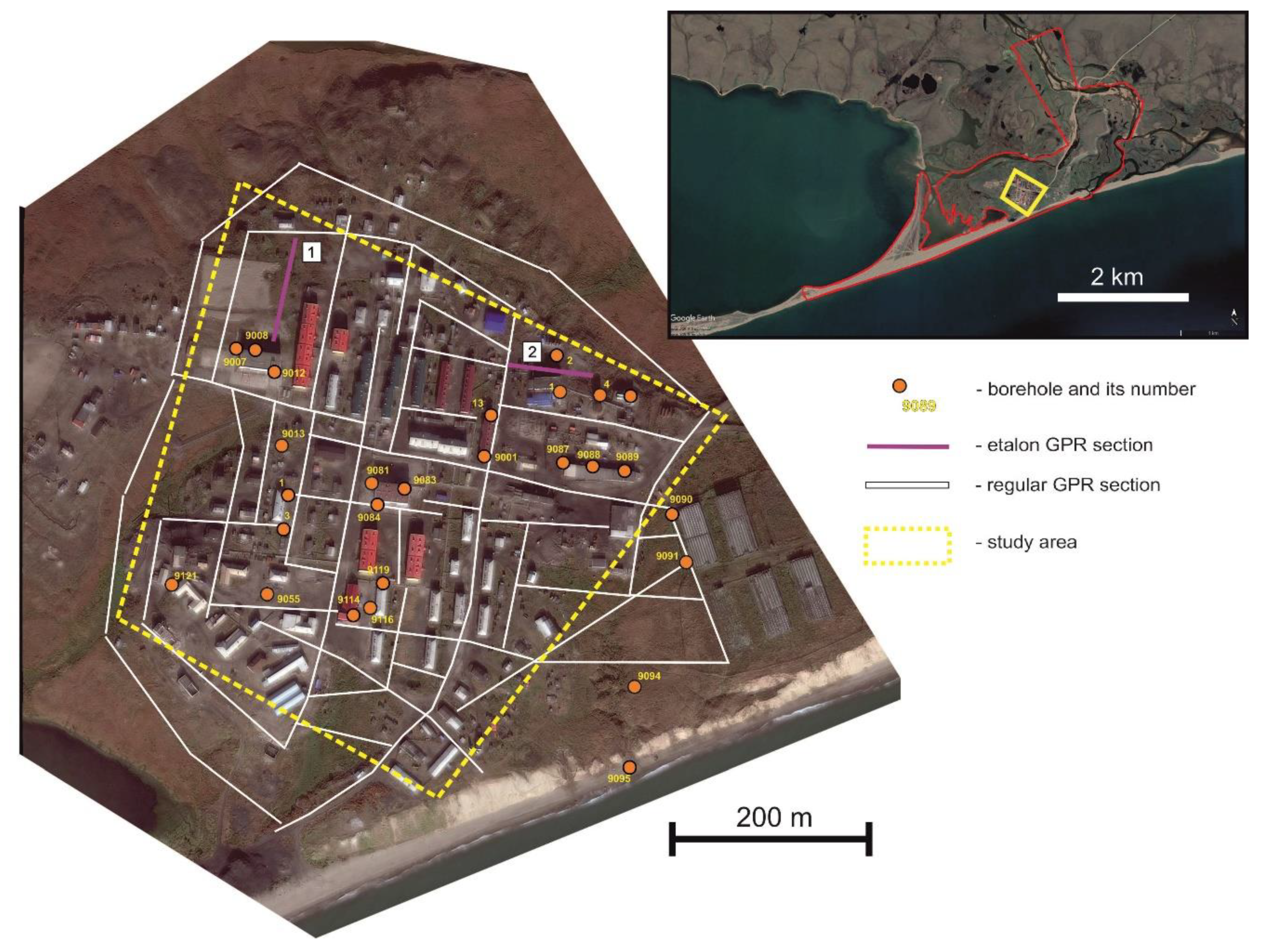
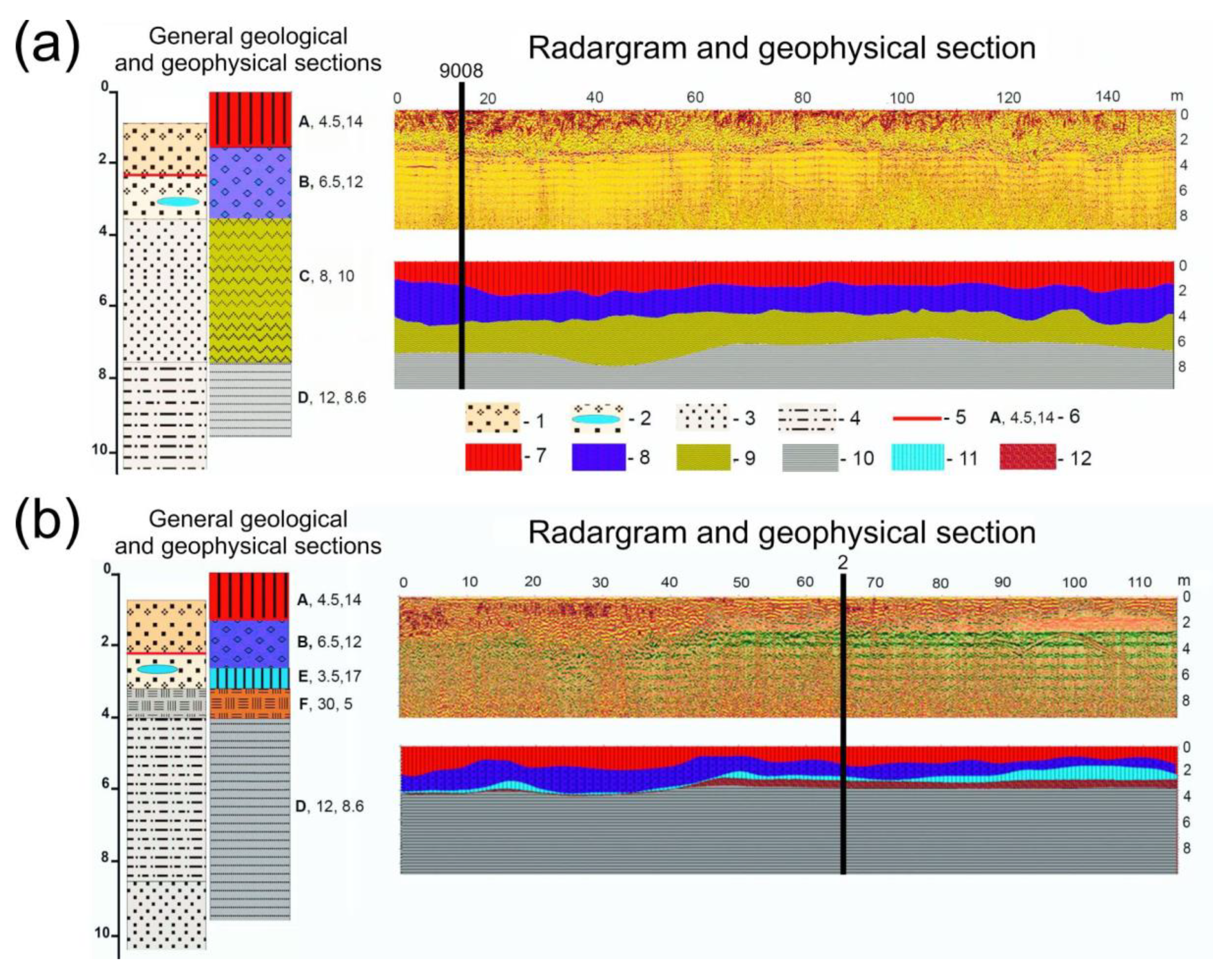
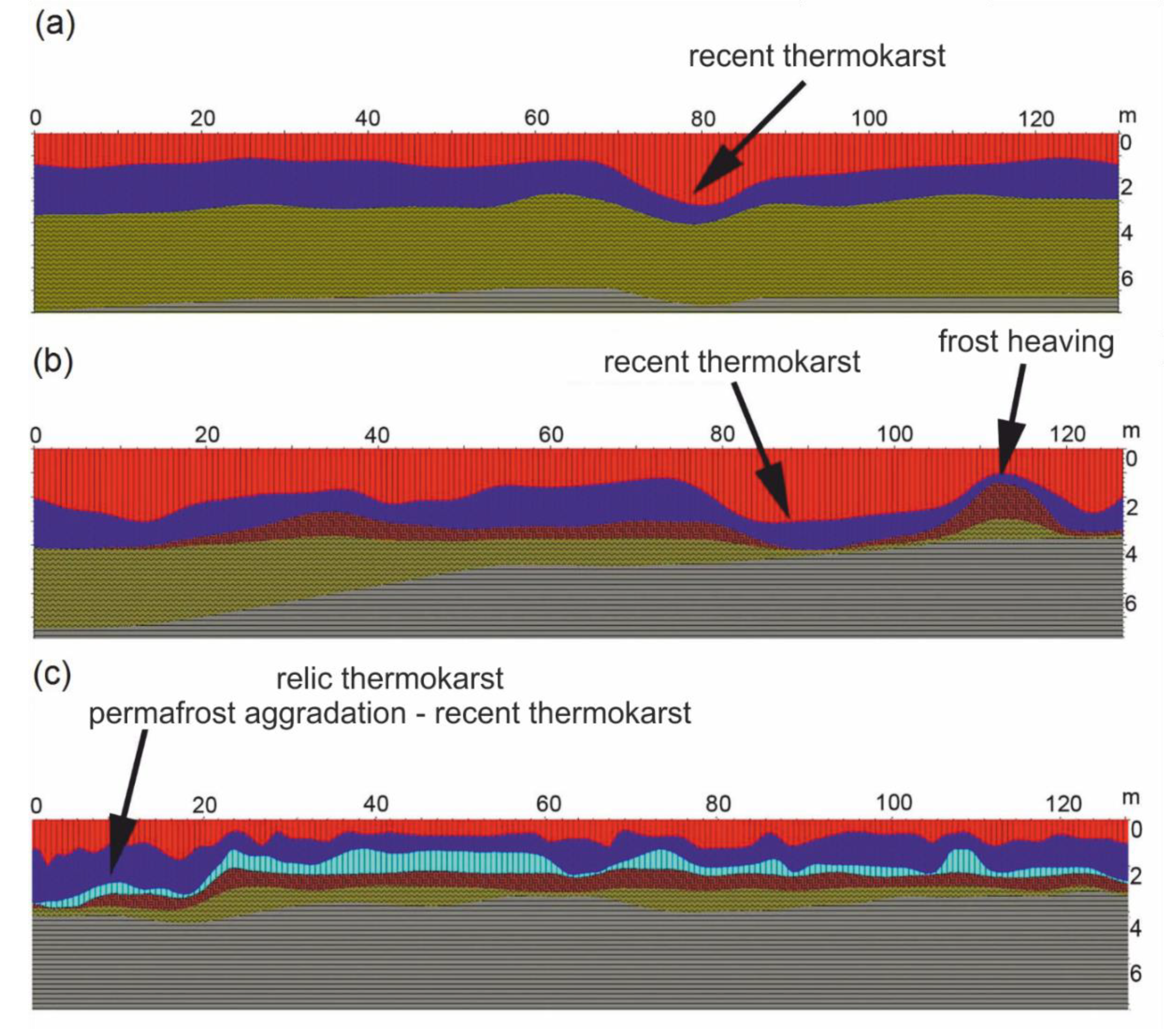
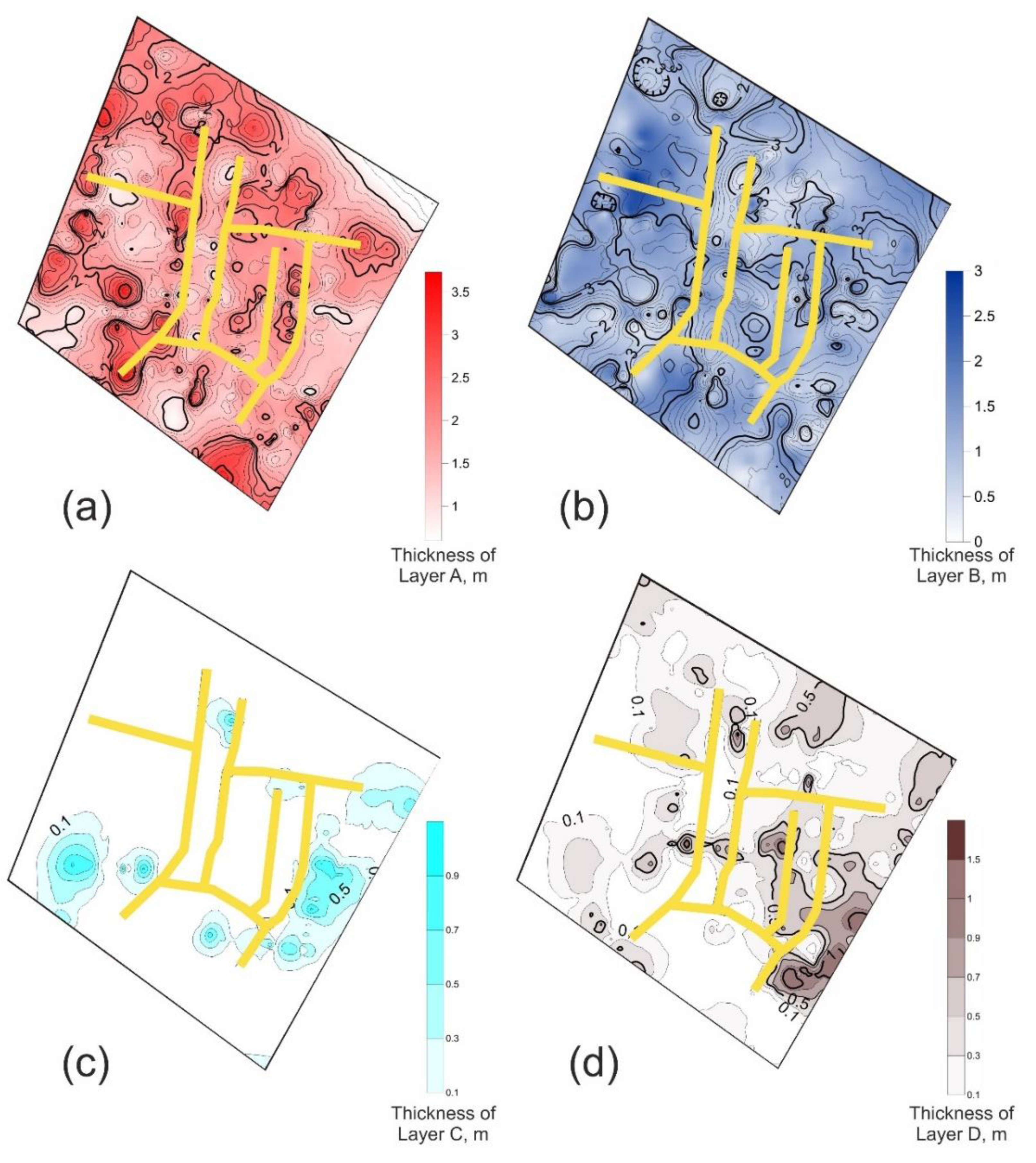
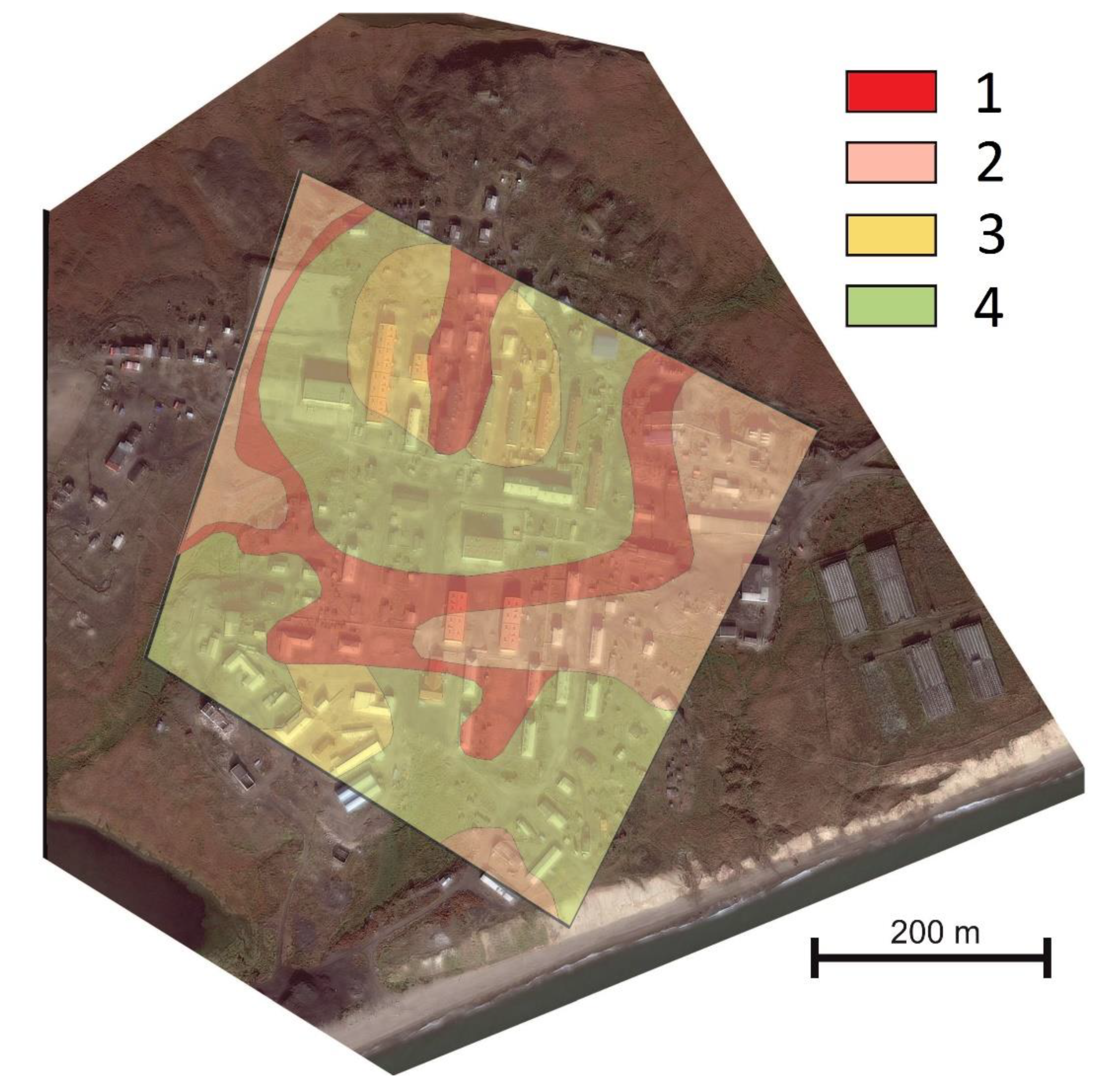
© 2020 by the authors. Licensee MDPI, Basel, Switzerland. This article is an open access article distributed under the terms and conditions of the Creative Commons Attribution (CC BY) license (http://creativecommons.org/licenses/by/4.0/).
Share and Cite
Tregubov, O.; Kraev, G.; Maslakov, A. Hazards of Activation of Cryogenic Processes in the Arctic Community: A Geopenetrating Radar Study in Lorino, Chukotka, Russia. Geosciences 2020, 10, 57. https://doi.org/10.3390/geosciences10020057
Tregubov O, Kraev G, Maslakov A. Hazards of Activation of Cryogenic Processes in the Arctic Community: A Geopenetrating Radar Study in Lorino, Chukotka, Russia. Geosciences. 2020; 10(2):57. https://doi.org/10.3390/geosciences10020057
Chicago/Turabian StyleTregubov, Oleg, Gleb Kraev, and Aleksey Maslakov. 2020. "Hazards of Activation of Cryogenic Processes in the Arctic Community: A Geopenetrating Radar Study in Lorino, Chukotka, Russia" Geosciences 10, no. 2: 57. https://doi.org/10.3390/geosciences10020057
APA StyleTregubov, O., Kraev, G., & Maslakov, A. (2020). Hazards of Activation of Cryogenic Processes in the Arctic Community: A Geopenetrating Radar Study in Lorino, Chukotka, Russia. Geosciences, 10(2), 57. https://doi.org/10.3390/geosciences10020057





